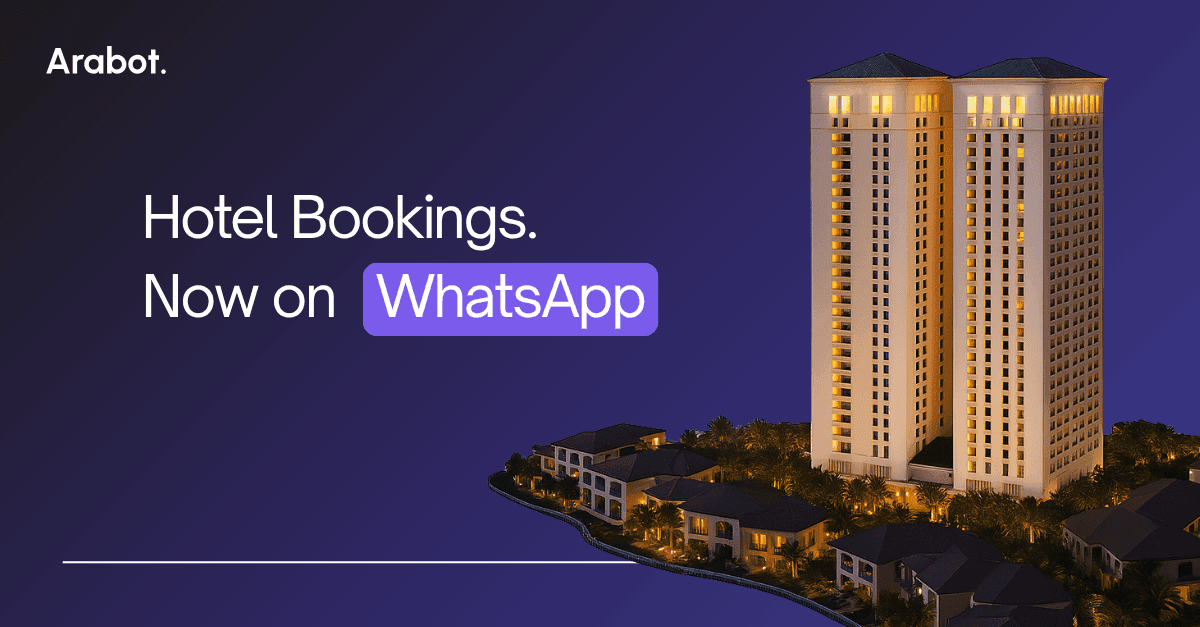- 1.
Understanding WhatsApp Flows
- 2.
Implementing Automated Follow-ups with WhatsApp Flows
- 3.
Integrating WhatsApp Flows with CRM Systems
- 4.
Scaling Your Follow-up Strategy with WhatsApp Flows
- 5.
Quick Guide: Creating a WhatsApp Flow with arabot's Bot Builder
- 6.
Supercharge Your WhatsApp Strategy with arabot
Education
WhatsApp Flows for Automating Followups like a Pro: Save Time and Effort with This One Simple Integration

Let's face it - manually following up with every lead can be time-consuming and inefficient. That's where WhatsApp Flows comes in, changing the way businesses handle follow-ups and customer interactions.
WhatsApp Flows is not just another messaging tool. It's a powerful feature that allows businesses to create automated, interactive conversation pathways directly within WhatsApp.
With WhatsApp Flows, you can streamline your follow-up process, boost engagement, and ultimately drive more conversions - all while saving valuable time and resources.
In this guide, we'll dive deep into tWhatsApp Flows and show you how to harness its potential for automating follow-ups like a pro. Whether you're a small business owner or part of a large marketing team, this blog post will equip you with the knowledge and strategies to take your customer communication to the next level.
Understanding WhatsApp Flows
Before we jump into the nitty-gritty of automating follow-ups, let's break down what WhatsApp Flows actually is and how it works.
What are WhatsApp Flows?
WhatsApp Flows is a feature within the WhatsApp Business Platform that enables businesses to design interactive and automated conversation pathways. These pathways guide customers through various interactions without ever leaving the familiar WhatsApp interface. From appointment bookings to lead qualification, WhatsApp Flows can handle a wide range of customer touchpoints seamlessly.
How do WhatsApp Flows enable automated follow-ups?
The beauty of WhatsApp Flows lies in its ability to create personalized, multi-step conversations that feel natural to the user. Here's how it works:
Trigger: A flow begins when a customer sends a specific message or interacts with a button in your WhatsApp business account.
Automated Responses: Based on the trigger, the flow sends pre-designed messages, questions, or prompts to the customer.
User Input: The customer responds to these prompts, providing information or making choices.
Conditional Logic: The flow uses this input to determine the next steps, creating a tailored experience for each user.
Action: Depending on the flow's design, it can perform actions like scheduling appointments, providing information, or escalating to a human agent when necessary.
By automating this process, WhatsApp Flows ensures that every lead receives timely, relevant follow-ups without requiring constant manual intervention from your team.
Types of Automated Follow-up Scenarios
WhatsApp Flows enables businesses to create various automated follow-up scenarios, streamlining customer interactions and improving engagement. Here are some key use cases:
1. Lead Nurturing Sequences
With WhatsApp Flows, you can set up automated lead nurturing sequences that guide potential customers through your sales funnel. For example:
- Send a welcome message when a new lead opts in
- Follow up with product information or educational content
- Offer a limited-time discount to encourage conversion
By automating these touchpoints, you ensure consistent communication without overwhelming your sales team.
2. Post-Purchase Follow-ups
Enhance customer satisfaction and encourage repeat business with automated post-purchase follow-ups:
- Send order confirmations and tracking information
- Request product reviews or feedback
- Offer complementary products or services
These automated messages keep customers informed and engaged after their purchase, potentially leading to additional sales opportunities.
3. Appointment Reminders and Confirmations
Reduce no-shows and improve scheduling efficiency with automated appointment-related messages:
- Send appointment confirmation immediately after booking
- Deliver reminders 24 hours and 1 hour before the appointment
- Allow easy rescheduling options within the chat
This automation not only saves time for your staff but also provides a convenient experience for your customers.
4. Re-engagement Campaigns
Reconnect with inactive customers or leads using automated re-engagement flows:
- Send personalized "We miss you" messages
- Offer special "comeback" discounts or promotions
- Share updates about new products or services
These campaigns can help reactivate dormant relationships and bring customers back into your sales funnel.
5. Customer Feedback Collection
- Automate the process of gathering valuable customer feedback:
- Send survey requests after a purchase or service interaction
- Use interactive elements to make feedback submission easy
- Follow up on negative feedback with personalized responses
By automating this process, you can consistently collect insights to improve your products or services.
Implementing Automated Follow-ups with WhatsApp Flows
- Define your objectives: Clearly outline what you want to achieve with each automated follow-up scenario.
- Design your flow: Map out the user journey, including decision points and potential paths.
- Create message templates: Develop engaging, personalized messages for each step in your flow.
- Set up triggers: Define the actions or timeframes that will initiate each automated sequence.
- Implement and test: Use the WhatsApp Flows Builder or JSON to create your flows, then thoroughly test them before going live.
- Monitor and optimize: Regularly review performance metrics and user feedback to refine your automated follow-ups.
By implementing these automated follow-up scenarios, you can significantly enhance your customer engagement, improve response times, and drive better business outcomes – all while saving time and resources for your team.
Personalizing Automated Follow-ups
When it comes to follow-ups, one size definitely doesn't fit all. Personalization is key to making your customers feel valued and understood. Here's how to nail it:
- Use customer data wisely: Leverage information from your CRM to tailor messages. A simple "Hey [First Name]" can go a long way.
- Segment your audience: Group customers based on their interests, purchase history, or engagement level. This allows you to send targeted messages that resonate.
- Dynamic content: Create message templates with variables that automatically populate based on user data. This could include recent purchases, abandoned cart items, or upcoming appointments.
- Behavioral triggers: Set up flows that respond to specific customer actions. For example, if someone views a product multiple times, trigger a follow-up with more details or a special offer.
Remember, the goal is to make each interaction feel personal and relevant, even when it's automated.
Timing and Frequency Best Practices
Timing is everything in follow-ups. Too soon, and you might seem pushy. Too late, and you've missed the opportunity. Here's how to get it right:
- Immediate responses: For certain actions like sign-ups or purchases, send an instant confirmation or welcome message.
- Strategic delays: For nurturing sequences, space out your messages. A good rule of thumb is to start with higher frequency (e.g., every other day) and then taper off (e.g., weekly, then monthly).
- Time zone considerations: Use your customer's local time zone to ensure messages arrive at appropriate hours.
- Optimal send times: Analyze your engagement data to find out when your audience is most responsive. This might vary depending on your industry and target demographic.
- Respect boundaries: Always provide clear opt-out options and honor customer preferences for communication frequency.
The key is to find the sweet spot between staying top-of-mind and avoiding message fatigue.
Integrating WhatsApp Flows with CRM Systems
A robust CRM integration can supercharge your WhatsApp follow-up strategy. Here's why it's crucial and how to do it effectively:
- Data synchronization: Ensure that customer interactions on WhatsApp are recorded in your CRM in real-time. This gives your team a 360-degree view of each customer's journey.
- Automated workflow triggers: Set up your CRM to automatically initiate WhatsApp flows based on specific events or milestones in the customer lifecycle.
- Personalization at scale: Use CRM data to inform your WhatsApp messages, making them more relevant and personalized without manual input.
- Lead scoring: Integrate WhatsApp engagement data into your lead scoring model to prioritize high-potential prospects.
- Analytics and reporting: Leverage your CRM's reporting capabilities to gain insights into the performance of your WhatsApp follow-up campaigns.
Scaling Your Follow-up Strategy with WhatsApp Flows
As your business grows, so will the volume of customer interactions. Here's how to scale your follow-up strategy effectively:
Managing high-volume conversations:
Use automated responses for common queries
Implement a triage system to prioritize urgent messages
Set up automated flows for different customer segments
Automating responses to FAQs:
Create a knowledge base of common questions and answers
Use keyword recognition to trigger appropriate responses
Regularly update your FAQ flows based on customer feedback
Using chatbots for initial triage:
Implement a chatbot to handle initial customer inquiries
Program the bot to escalate complex issues to human agents
Continuously train your chatbot to improve its effectiveness
Balancing automation with human touch:
Use automation for routine tasks, but keep personalized responses for complex issues
Train your team to seamlessly take over from automated flows when necessary
Regularly review automated interactions to ensure they maintain your brand voice
Remember, the goal is to enhance customer experience, not replace human interaction entirely.
Quick Guide: Creating a WhatsApp Flow with arabot's Bot Builder
Step 1: Log in to arabot's Bot Builder
- Navigate to the arabot platform and log in to your account.
- From the dashboard, select "Bot Builder" or "Create New Bot."
Step 2: Create a WhatsApp Flow Integration
- In the Bot Builder interface, look for an option like "Integrate Channels"
- Select "WhatsApp" as your integration channel.
- Select the "..." and choose WhatsApp Flows
- Create and then edit the screen
Step 3: Set Up the First Screen
In the flow builder, start with your welcome message.
Add the following elements to your first screen:
Text message: "Welcome to our service! How can we help you today?"
Quick Reply Buttons:
"Product Information"
"Place an Order"
"Customer Support"
Step 4: Create the Second Screen
For each quick reply option, create a new branch in your flow.
Let's focus on the "Product Information" path:
Add a text message: "Great! What type of product are you interested in?
Create a list or carousel of product categories (e.g., Electronics, Clothing, Home Goods)
Step 5: Design the Third Screen
For each product category, create a new branch.
Let's use "Electronics" as an example:
- Add a text message: "Here are our top electronic products:"
- Create a carousel of product images with brief descriptions
- Add "Learn More" buttons for each product
- Include an option to "Speak with a Representative"
Step 6: Add Final Interactions
For the "Learn More" buttons:
- Create a detailed product description screen
- Add options to "Add to Cart" or "Return to Categories"
For "Speak with a Representative"
- Add a message: "Connecting you with a customer service agent. Please wait."
- Implement a handover protocol to transfer to a live agent
Supercharge Your WhatsApp Strategy with arabot
Now that you've learned the ins and outs of WhatsApp Flows, it's time to unlock their full potential. arabot offers a powerful solution to streamline your WhatsApp automation and take your customer interactions to new heights.
Why Choose arabot for Your WhatsApp Flows?
- Intuitive Flow Builder: Create complex, personalized conversation flows without any coding knowledge.
- Seamless Integration: Connect your WhatsApp Business API effortlessly with arabot's platform.
- Advanced AI Capabilities: Leverage natural language processing to understand and respond to customer queries more effectively.
- Rich Media Support: Enhance your flows with images, videos, and interactive elements to boost engagement.
- Analytics and Insights: Gain valuable data on your WhatsApp performance to continually optimize your strategy.
Take the Next Step
Ready to change how you use WhatsApp for your marketing and lead gen efforts? Book a demo with arabot today and discover how our platform can help you:
- Increase customer satisfaction
- Streamline your workflow
- Scale your WhatsApp operations effortlessly
Book your demo now!
© 2025 copyright Arabot. All rights reserved.
 Insurance
Insurance Healthcare
Healthcare Automative
Automative Hospitality
Hospitality Banking
Banking Government
Government Telecommunication
Telecommunication Education
Education Human Resources
Human Resources
